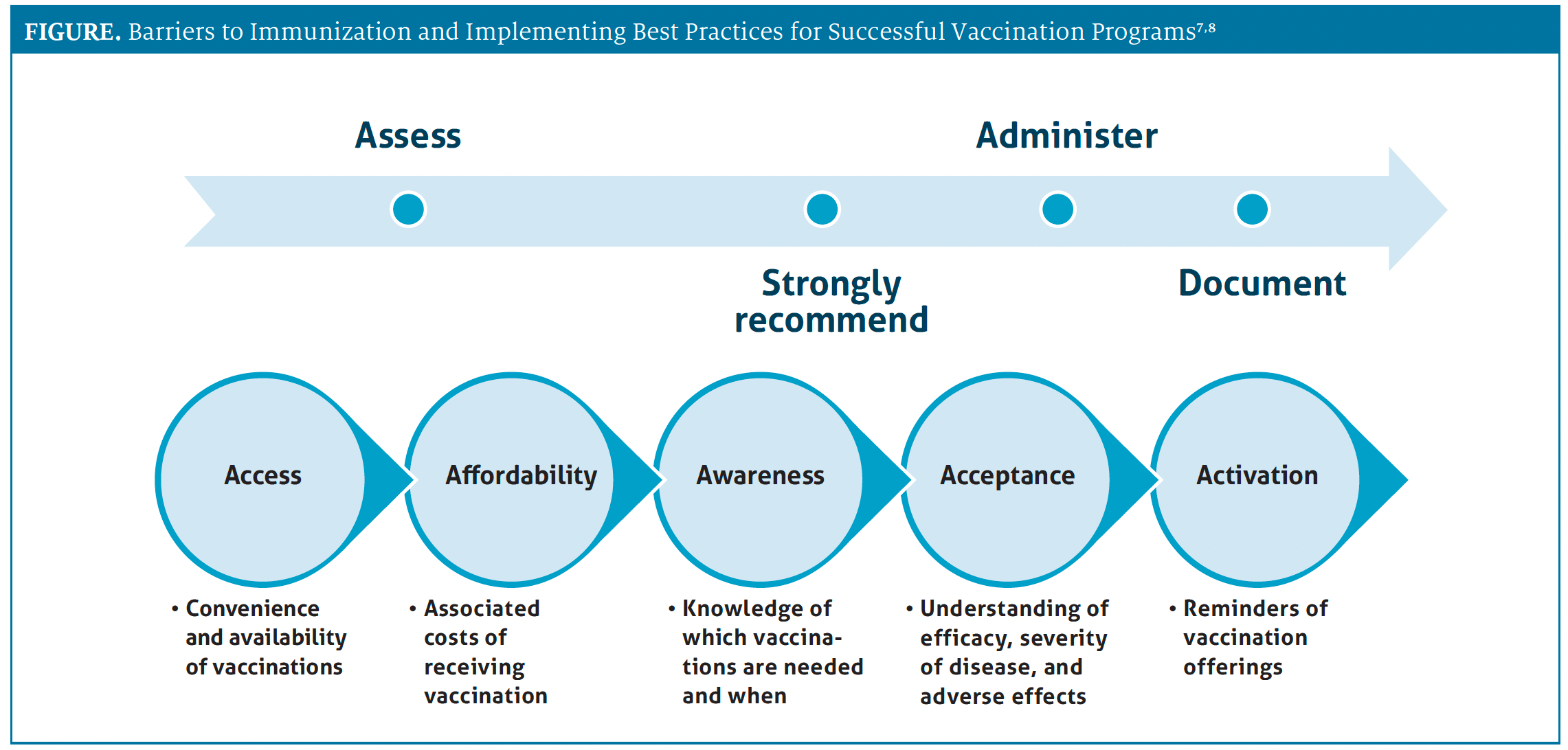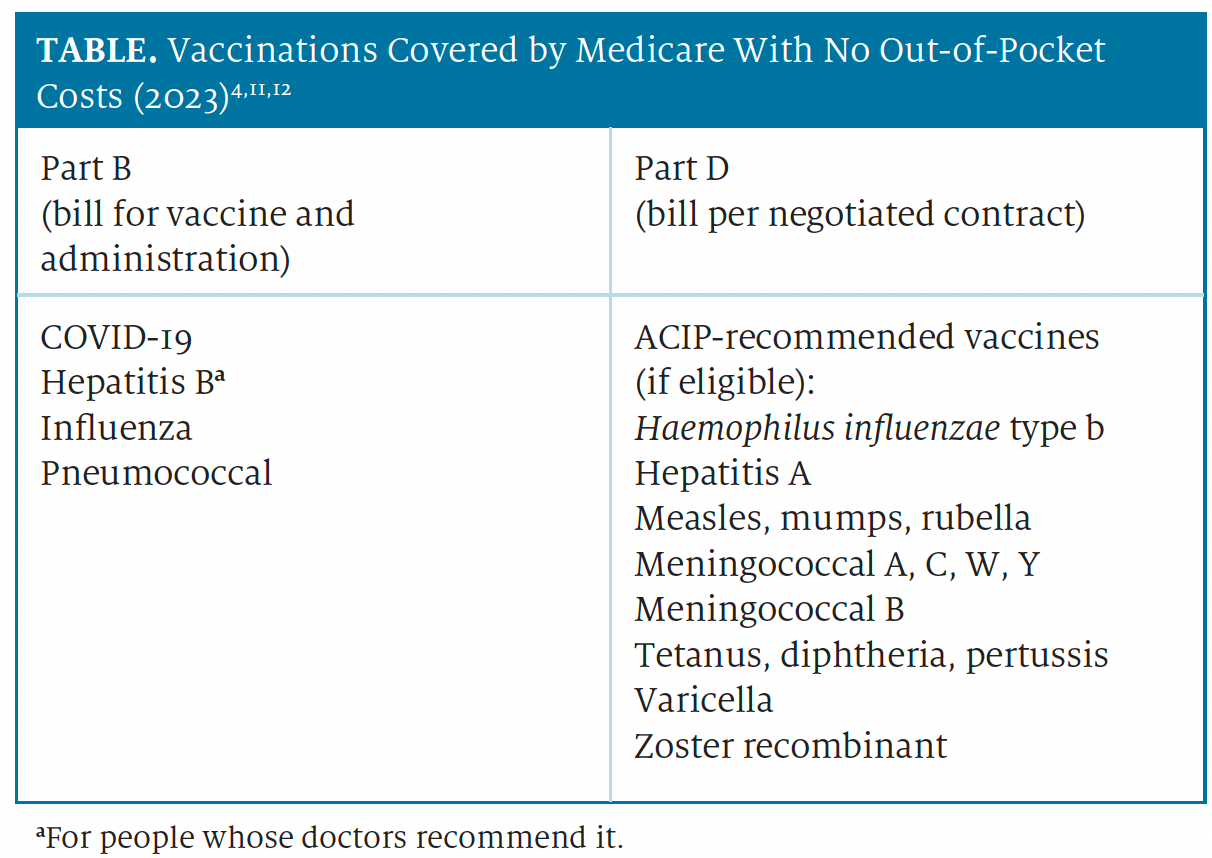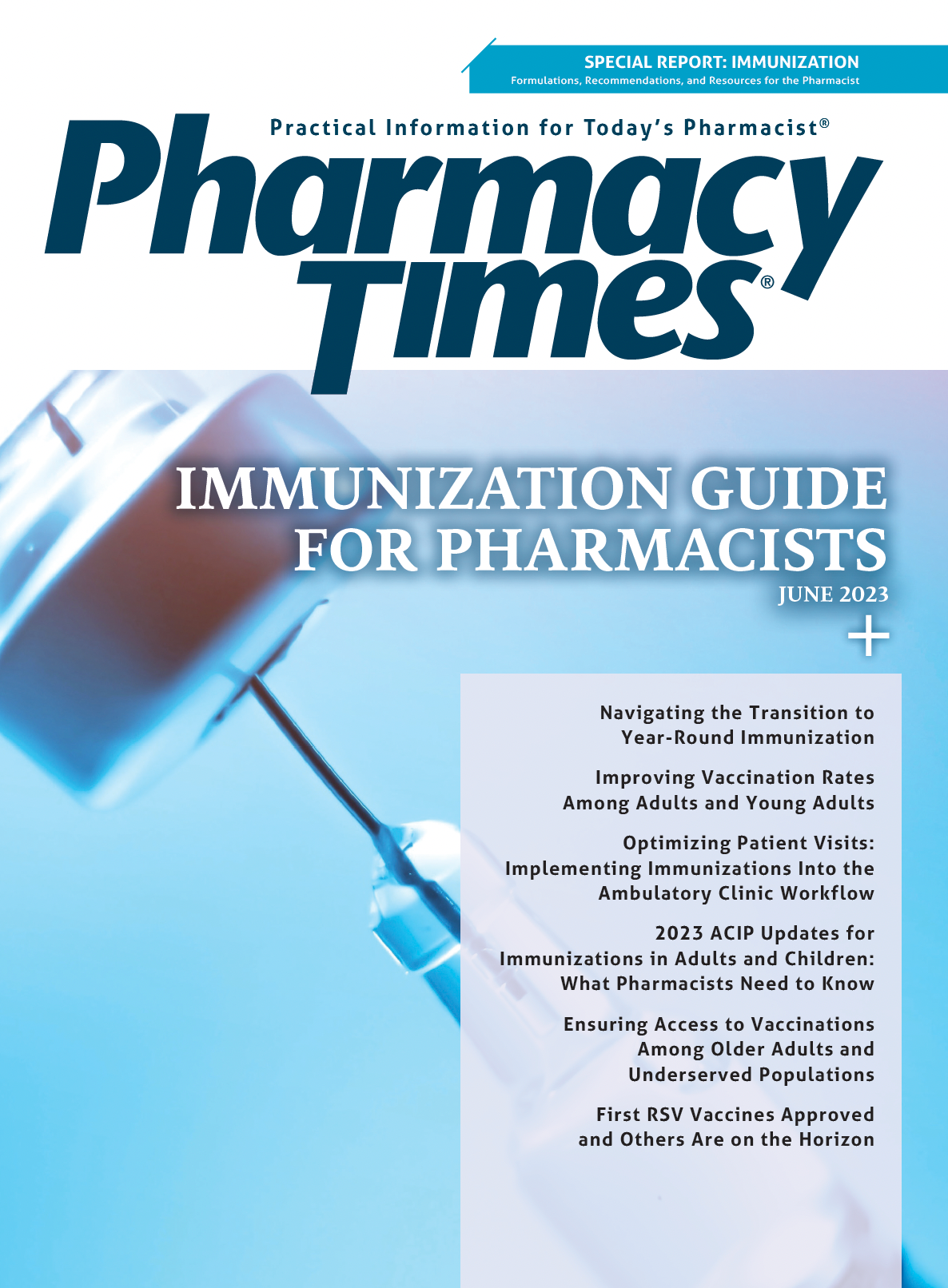Publication
Article
Supplements
Ensuring Access to Vaccinations Among Older Adults and Underserved Populations
Author(s):
A broader understanding of vaccine hesitancy and barriers has helped to enhance acceptance of vaccination services through educational outreach.
In the early 21st century, following the H1N1 influenza pandemic, vaccination efforts primarily focused on influenza and the expanded recommendation from the Advisory Committee on Immunization Practices (ACIP) for all individuals who are at least 6 months of age to receive an annual influenza vaccination.1 Public health initiatives grew rapidly to include the engagement of pharmacists in enhanced vaccine program efforts. As the US population continues to age and new successful vaccinations (eg, herpes zoster and human papillomavirus) have been produced,2 pharmacies have become a vaccination destination. Similar to the H1N1 outbreak, the COVID-19 pandemic led to the establishment of COVID-19 vaccination and booster programs, which has led to pharmacies becoming even better prepared to administer vaccinations on a large scale. The pandemic highlighted the immense importance of being able to implement public health initiatives quickly, and pharmacists and staff were critical in the administration of the novel COVID-19 vaccines; they also took on the new responsibility of offering other routine immunizations to additional patient populations.3
Daniel CHETRONI - stock.adobe.com

Indeed, global, federal, and state agencies have historically executed various projects to promote vaccinations, yet vaccination rates in adults have not met the goal.4 Older adults (aged ≥ 65 years) remain particularly vulnerable to vaccine-preventable diseases (VPDs) and they represent 95% of annual deaths due to VPDs (predominantly influenza).4 Additionally, older adults are more likely than younger individuals to experience complications (eg, hospitalization) from influenza and pneumococcal disease.5 Medicare beneficiaries have coverage for the recommended influenza and pneumococcal vaccines; however, cost-sharing for other immunizations, such as herpes zoster, depends on the Part D plan (if applicable).4 Although cost-sharing can be a barrier to some vaccines, it does not explain suboptimal coverage rates for other vaccines. Older adults represent a growing proportion of the US population; therefore, it is imperative to pinpoint vaccine barriers for this demographic.
Pharmacy Execution of Vaccine Services
To close current gaps in vaccination rates and ensure coverage to newly eligible patients, a robust vaccine-focused strategy is imperative across the health care spectrum, but particularly in pharmacies.4,6 Studies have found myriad reasons and culpability for vaccination gaps, hesitancies, and barriers, which are best summarized by using the 5 As: access, affordability, awareness, acceptance, and activation.7 Health care legislation and public health initiatives have enabled health care providers to address the variables related to vaccination uptake, particularly access and affordability, but more work needs to be done.3,7 Vaccination programs that couple the 5As with the CDC’s Standards for Adult Immunization Practice (Figure) are most likely to be successful.7,8
Image From Pharmacy Times® Immunization Guide for Pharmacists June 2023

A review of studies assessing uptake of the influenza vaccine in the adult population (aged 18-64 years) identified that lack of knowledge (about both the influenza vaccine in particular and the entire vaccine process in general) is the greatest barrier to vaccination; cost was not determined to be a top impediment.6 Development and execution of vaccine educational programs are crucial to increase public acceptance of vaccinations. Empowering older adults with information focused on vaccine effectiveness, mortality rates, and susceptibility to VPDs can promote these endeavors.9 A survey of 610 respondents who were at least 50 years of age revealed that vaccine efficacy was the most important factor that patients considered, not mild adverse events or the number of vaccines required for protection.9 Additionally, a review of 30 studies that assessed the success of vaccination promotion found that patients’ trust in health care providers was one of the most important factors influencing their decision to receive a vaccination.6 Pharmacists are considered to be among the most trusted members of a health care team,10 and their focus on methods to combat vaccine acceptance through education and knowledge of vaccines and VPDs is valuable. COVID-19 vaccination efforts have improved communication about vaccines, but addressing prepandemic barriers, such as the efficacy and safety concerns associated with vaccines, is imperative for future vaccination efforts.6
The last of the 5As, “activation” is defined as “the degree to which individuals are nudged toward vaccine uptake.”7 Practice standards for adult immunization developed by the US Department of Health and Human Services National Vaccine Advisory Committee suggest that all health care providers review and assess their patients’ immunization status during every encounter this can be accomplished via encouragement to receive a recommended vaccination or the implementation of a vaccination reminder program.8 Sending patients reminders (text prompts, telephone calls, emails) as well as takeaway items (immunization cards, leaflets) can help. Increased vaccination rates have been demonstrated in facilities where these programs were in place, compared with facilities without these reminder programs.7 Furthermore, reminder initiatives are particularly important to facilitate the completion of vaccination series. Every member of the pharmacy team should be knowledgeable and engaged in state immunization registry retrieval, aware of local programs and activities to increase immunization, and immediately available to administer immunizations so that every patient encounter is complete.8
Inflation Reduction Act and Impact on Vaccination Services
Vaccination plan coverage for Medicare beneficiaries varies among plans. Part B physician and preventive services includes no-cost influenza, pneumococcal, COVID-19, and hepatitis B vaccination coverage for eligible patients (Table).4,11,12 All other vaccinations recommended by ACIP, for example, herpes zoster and Tdap, depend on supplemental or prescription part D coverage. This can result in varying coverage, costs, and adherence related to vaccines, especially for those given in a series.13
Image From Pharmacy Times® Immunization Guide for Pharmacists June 2023

In August 2022, President Joseph R. Biden signed the Inflation Reduction Act (IRA), which covers a variety of public health, energy, and conservation adoptions and goals for the country.14 Over the next 6 years, the Centers for Medicare & Medicaid Services and their beneficiaries are primed to experience numerous financial impacts for covered services and medications—including a yearly $2000 cap on out-of-pocket costs for prescription drugs. Additionally, this legislation opens the door for negotiation between Medicare and prescription drug manufacturers to reduce medication costs for the covered entities.15,16
Under the IRA, and beginning on January 1, 2023, all ACIP-recommended vaccinations for Medicare Part D beneficiaries are covered without any out-of-pocket costs, regardless of plan coinsurance and deductible. This coverage will expand for most adults with Medicaid and the Children’s Health Insurance Program coverage by October 1, 2023.17 More than 135 million Americans will be covered across these 3 programs,18 and this expansion will allow for access to vaccinations previously hindered by vaccine affordability. This legislation opens a multitude of doors to administer vaccinations or boosters that may have been too expensive for some people.
Although this is a considerable step toward improving vaccine coverage, there are still millions of Americans without insurance or the ability to afford vaccinations. There are an estimated 15 million Medicare beneficiaries who are not enrolled in a part D prescription drug plan and therefore bear the responsibility for the cost of life-saving vaccinations.19 The next few years of cost reductions in Medicare and Medicaid could lead to cost transference by pharmaceutical companies, shifting fee increases to private plans, which could decrease the number of individuals who have sufficient coverage.20 The evolution and execution of a Vaccines for Adults plan (modeled after the current Vaccines for Children federally funded program) could expand vaccination coverage for these patients, as well as the uninsured and underinsured adult American population (aged 18-64 years).21,22 Some states have employed these plans following COVID-19 vaccination efforts; however, a federal program that would ensure immunization access to every adult was proposed in the 2023 fiscal year budget from the White House.
Medicare Part B and Part D benefits also incur different billing and reimbursement schedules. Part D plan benefits are negotiated with the pharmacy during the contracting period and, therefore, they may have varying administration fees from network to network. It is recommended to parallel contracted administration fees similar to those calculated in Part B codes: professional’s time, vaccination supplies, indirect costs, and professional liability.11 Part B billing requires the pharmacy to be registered with Medicare through the CMS-855 form; enrollment is now available online.23 Medicare will reimburse for both the cost of the vaccine as well as administration for Part B-covered formularies (annual influenza season/pricing schedules start August 1).23,24 Each Part B vaccine must be billed separately and both codes must be supplied for complete reimbursement.24 Guidance was updated via CMS.gov regarding COVID-19 vaccinations with the end of the COVID-19 Declaration of a Public Health Emergency.25 There are no out-of-pocket costs for Medicare members.
Opportunities to Improve Access to Vaccinations for Racial and Ethnic Minority Populations
Elimination of vaccination inequities should be a local, state, federal, and global primary initiative. Although measures are underway to ensure protection for every child to fully execute the childhood vaccination schedule, adult populations must uphold similar practices to stay up-to-date on their preventive care. Attitudes toward vaccine practices are multifactorial, and societal factors can largely contribute to vaccination barriers in different communities. Furthermore, generational barriers having to do with distrust of the government and the health care system often correlate to vaccination practices.1 For example, younger generations of African American heritage have shown to be more trusting of the government and of influenza vaccines compared with their older counterparts.26 Results from a Morbidity and Mortality Weekly Report using 2018 data suggested racial disparities among adults for all ACIP vaccinations.13 In a review of eligible studies from 1997 to 2015, Jain and colleagues found that older adults who lived alone or were unmarried have a lower uptake of vaccinations.27 Additionally, racial and ethnic minorities, older adults, and people with disabilities were more likely to have inadequate transportation services to and from health care facilities and pharmacies for vaccination services, which can impede uptake.1
Heath care initiatives must include collaboration and community outreach and engagement to ensure that all Americans have access to vaccinations. Vaccination clinics held in alternative locations outside of the brick-and-mortar pharmacy help to overcome both physical and societal barriers. By working with religious organizations, community centers, gyms, schools, and other community or neighborhood groups, pharmacists can find opportunities to reach a variety of communities and groups to provide vaccine education and administer immunizations.1 Organizations such as the CDC and the World Health Organization (WHO) offer ready-made educational materials to use at these off-site clinics as well. Educational materials that are made available before, during, and after an event can help to increase the participants’ likelihood of seeking vaccination services.6 Public health initiatives, with facilitation and funding from the Public Readinessand Emergency Preparedness Act and the Inflation Reduction Act, can help address access, affordability, and awareness, but it is up to health care providers in the pharmacy and community to execute vaccineacceptance and activation.7,16,28
Conclusions
The vast deployment of COVID-19 vaccinations worldwide was the epitome of using the 5As to vaccinate the public. The pandemic prompted newlegislation, such as the Inflation Reduction Act, to continue upholding sound public health practices. American adults now have expanded physical access to immunizations in more pharmacies across the nation. Medicare and Medicaid beneficiaries now have increased affordability for all ACIP-recommended vaccinations through the extension of no-cost benefits and drug manufacturer negotiations. Media platforms and campaigns have ignited broad awareness of vaccination services. A broader understanding of vaccine hesitancy and barriers has helped to enhance acceptance of vaccination services through educational outreach. Activation of enhanced technology for vaccination programs has helped to close gaps in care. Pharmacists can continue to provide essential vaccination support for older adults and for underserved communities and contribute to the fulfillment of the WHO Immunization Agenda 2030 vision of “a world where everyone, everywhere, at every age, fully benefits from vaccines for good health and well-being.”29
About The Author
Jerica Singleton, PharmD, is an assistant professor in the Department of Pharmacotherapeutics & Clinical Research at Taneja College of Pharmacy at the University of South Florida in Tampa, Florida.
References
1. Breaux RD, Rooks RN. The intersectional importance of race/ethnicity, disability, and age in flu vaccine uptake for U.S. adults. SSM Popul Health. 2022;19:101211. doi:10.1016/j.ssmph.2022.101211
2. Amanna IJ, Slifka MK. Successful vaccines. Curr Top Microbiol Immunol. 2020;428:1-30. doi:10.1007/82_2018_102
3. AlMahasis SO, Fox B, Ha D, Qian J, Wang CH, Westrick SC. Pharmacy-based immunization in rural USA during the COVID-19 pandemic: a survey of community pharmacists from five southeastern states. Vaccine. 2023;41(15):2503-2513. doi:10.1016/j.
vaccine.2023.03.002
4. Shen AK, Warnock R, Selna W, MaCurdy TE, Chu S, Kelman JA. Vaccination among Medicare-fee-for service beneficiaries: characteristics and predictors of vaccine receipt, 2014-2017. Vaccine. 2019;37(9):1194-1201. doi:10.1016/j.vaccine.2019.01.010
5. Winston CA, Wortley PM, Lees KA. Factors associated with vaccination of Medicare beneficiaries in five U.S. communities: results from the racial and ethnic adult disparities in immunization initiative survey, 2003. J Am Geriatr Soc. 2006;54(2):303-310. doi:10.1111/j.1532-5415.2005.00585.x
6. Welch VL, Metcalf T, Macey R, et al. Understanding the barriers and attitudes toward influenza vaccine uptake in the adult general population: a rapid review. Vaccines. 2023;11(1):180. doi:10.3390/vaccines11010180
7. Thomson A, Robinson K, Vall.e-Tourangeau G. The 5As: a practical taxonomy for the determinants of vaccine uptake. Vaccine. 2016;34(8):1018-1024. doi:10.1016/j.vaccine.2015.11.065
8. Standards for adult immunization practices. CDC. Updated May 2, 2016. Accessed April 29, 2023. https://www.cdc.gov/vaccines/hcp/adults/for-practice/standards/index.html
9. Eilers R, de Melker HE, Veldwijk J, Krabbe PFM. Vaccine preferences and acceptance of older adults. Vaccine. 2017;35(21):2823-2830. doi:10.1016/j.vaccine.2017.04.014
10. Shen AK, Tan ASL. Trust, influence, and community: why pharmacists and pharmacies are central for addressing vaccine hesitancy. J Am Pharm Assoc. 2022;62(1):305-308. doi:10.1016/j.japh.2021.10.00111
11. Prescription Drug Benefit Manual. CMS.gov. Updated December 1, 2021. Accessed April 29, 2023. https://www.cms.gov/Medicare/Prescription-Drug-Coverage/PrescriptionDrugCovContra/PartDManuals
12. Adult immunization schedule by age. CDC. Updated April 27, 2023. Accessed May 10, 2023. https://www.cdc.gov/vaccines/schedules/hcp/imz/adult.html#table-age
13. Lu PJ, Hung MC, Srivastav A, et al. Surveillance of vaccination coverage among adult populations — United States, 2018. MMWR Surveill Summ. 2021;70(3):1-26. doi:10.15585/mmwr.ss7003a1
14. H.R.5376 - Inflation Reduction Act of 2022. Congress.gov. Accessed May 8, 2023. https://www.congress.gov/bill/117th-congress/housebill/5376
15. Selected health provisions of the Inflation Reduction Act. Congressional Research Service. Published September 1, 2022. Accessed April 29, 2023. https://crsreports.congress.gov/product/pdf/IF/IF12203
16. Inflation reduction act and Medicare. Centers for Medicare & Medicaid Services. Accessed April 29, 2023. https://www.cms.gov/inflation-reduction-act-and-medicare
17. Inflation reduction act: CMS implementation timeline. Centers for Medicare & Medicaid Services. Updated April 28, 2023. Accessed April 28, 2023. https://www.cms.gov/files/document/10522-inflation-reduction-act-timeline.pdf
18. News alert CMS releases latest enrollment figures for Medicare, Medicaid, and Children’s Health Insurance Program (CHIP). Centers for Medicare & Medicaid Services. December 21, 2021. Accessed April 30, 2023. https://www.cms.gov/newsroom/news-alert/cms-releaseslatest-enrollment-figures-medicare-medicaid-and-childrenshealth-insurance-program-chip
19. Medicare beneficiaries at a glance. Centers for Medicare & Medicaid Services. 2021. Accessed May 10, 2023. https://www.cms.gov/Research-Statistics-Data-and-Systems/Statistics-Trends-and-Reports/Beneficiary-Snapshot/Downloads/Bene_Snaphot.pdf
20. Nasir K, Salami JA, Mossialos E. Prescription for affordable health care: promise and perils of Inflation Reduction Act tackling financial toxicity. J Am Coll Cardiol. 2023;81(15):1502-1504. doi:10.1016/j.jacc.2023.02.028
21. Department of Health and Human Services. Food and Drug Administration: federal funds. Accessed April 30, 2023. https://www.whitehouse.gov/wp-content/uploads/2022/03/hhs_fy2023.pdf
22. Hughes IV R. The Inflation Reduction Act will help the U.S. achieve maximum vaccine access and uptake, but access gaps remain. STAT. September 27, 2022. Accessed April 29, 2023. https://www.statnews.com/2022/09/27/inflation-reduction-act-improves-vaccineaccess-but-gaps-remain/
23. How to bill Medicare for influenza and pneumococcal vaccinations. Centers for Medicare & Medicaid Services. Accessed April 30, 2023. https://www.cms.gov/files/document/flupdfpdf
24. Seasonal influenza vaccines pricing. CMS.gov. January 4, 2023. Accessed May 14, 2023. https://www.cms.gov/medicare/medicare-feefor-service-part-b-drugs/mcrpartbdrugavgsalesprice/vaccinespricing
25. Medicare billing for COVID-19 vaccine shot administration. CMS.gov. May 12, 2023. Accessed May 14, 2023. https://www.cms.gov/medicare/covid-19/medicare-billing-covid-19-vaccine-shot-administration
26. Jamison AM, Quinn SC, Freimuth VS. “You don’t trust a government vaccine”: narratives of institutional trust and influenza vaccination among African American and white adults. Soc Sci Med. 2019;221:87-94. doi:10.1016/j.socscimed.2018.12.020
27. Jain A, van Hoek AJ, Boccia D, Thomas SL. Lower vaccine uptake amongst older individuals living alone: a systematic review and meta-analysis of social determinants of vaccine uptake. Vaccine. 2017;35(18):2315-2328. doi:10.1016/j.vaccine.2017.03.013
28. Public Readiness and Emergency Preparedness (PREP) Act update. Administration for Strategic Preparedness & Response. HHS.gov. Accessed May 14, 2023. https://aspr.hhs.gov/legal/PREPact/Pages/default.aspx
29. Immunization agenda 2030: a global strategy to leave no one behind. World Health Organization. Accessed May 13, 2023. https://cdn.who.int/media/docs/default-source/immunization/strategy/ia2030/ia2030-draft-4-wha_b8850379-1fce-4847-bfd1-5d2c9d9e32f8.pdf?sfvrsn=5389656e_66&download=true

Newsletter
Stay informed on drug updates, treatment guidelines, and pharmacy practice trends—subscribe to Pharmacy Times for weekly clinical insights.






